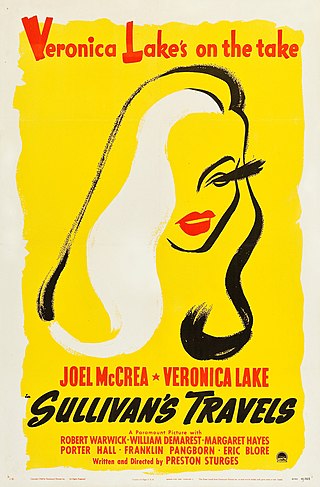
Sullivan's Travels is a 1941 American comedy film written and directed by Preston Sturges. A satire on the film industry, it follows a famous Hollywood comedy director who, longing to make a socially relevant drama, sets out to live as a tramp to gain life experience for his forthcoming film. Along the way he unites with a poor aspiring actress who accompanies him. The title is a reference to Gulliver's Travels, the 1726 novel by satirist Jonathan Swift about another journey of self-discovery.
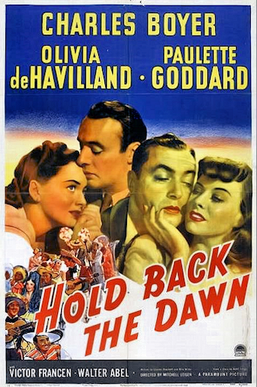
Hold Back the Dawn is a 1941 American romantic drama film in which a Romanian gigolo marries an American woman in Mexico in order to gain entry to the United States, but winds up falling in love with her. It stars Charles Boyer, Olivia de Havilland, Paulette Goddard, Victor Francen, Walter Abel, Curt Bois, Rosemary DeCamp, and an uncredited Veronica Lake.

Stanislaus Pascal Franchot Tone was an American actor, producer, and director of stage, film and television. He was a leading man in the 1930s and early 1940s, and at the height of his career was known for his gentlemanly sophisticate roles, with supporting roles by the 1950s. His acting crossed many genres including pre-Code romantic leads to noir layered roles and World War I films. He appeared as a guest star in episodes of several golden age television series, including The Twilight Zone and The Alfred Hitchcock Hour while continuing to act and produce in the theater and movies throughout the 1960s.

The Blue Dahlia is a 1946 American crime film and film noir with an original screenplay by Raymond Chandler directed by George Marshall and starring Alan Ladd, Veronica Lake and William Bendix. It was Chandler's first original screenplay.
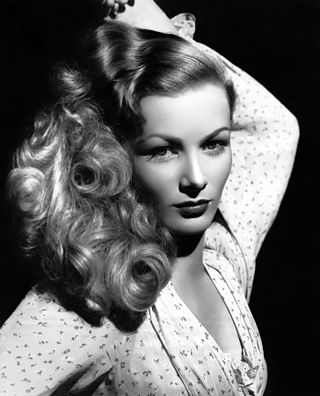
Constance Frances Marie Ockelman, known professionally as Veronica Lake, was an American film, stage, and television actress. Lake was best known for her femme fatale roles in film noirs with Alan Ladd during the 1940s, her peek-a-boo hairstyle, and films such as Sullivan's Travels (1941) and I Married a Witch (1942). By the late 1940s, Lake's career began to decline, due in part to her alcoholism. She made only one film in the 1950s, but made several guest appearances on television. She returned to the big screen in 1966 in the film Footsteps in the Snow (1966), but the role failed to revitalize her career.

This Gun for Hire is a 1942 American film noir crime film directed by Frank Tuttle and starring Veronica Lake, Robert Preston, Laird Cregar, and Alan Ladd. It is based on the 1936 novel A Gun for Sale by Graham Greene.
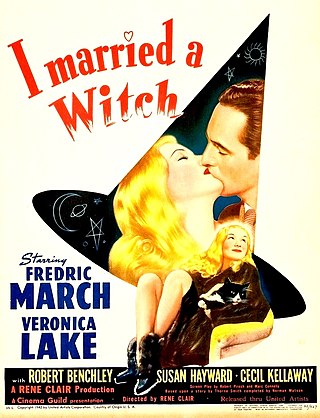
I Married a Witch is a 1942 American fantasy romantic comedy film, directed by René Clair, and starring Veronica Lake as a witch whose plan for revenge goes comically awry, with Fredric March as her foil. The film also features Robert Benchley, Susan Hayward and Cecil Kellaway. The screenplay by Robert Pirosh and Marc Connelly and uncredited other writers, including Dalton Trumbo, is based on the 1941 novel The Passionate Witch by Thorne Smith, who died before he could finish it; it was completed by Norman H. Matson.
Frank Wright Tuttle was a Hollywood film director and writer who directed films from 1922 to 1959.
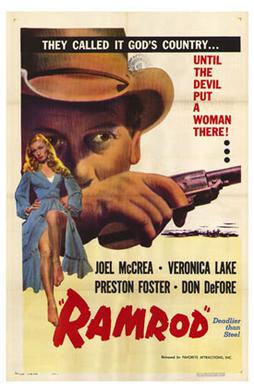
Ramrod is a 1947 American Western film directed by Andre DeToth and starring Joel McCrea, Veronica Lake, Preston Foster and Don DeFore. This cowboy drama from Hungarian director DeToth was the first of several films based on the stories of Western author Luke Short. DeToth's first Western is often compared to films noir released around the same time. Leading lady Veronica Lake was then married to director DeToth. The supporting cast features Donald Crisp, Charles Ruggles, Lloyd Bridges and Ray Teal.
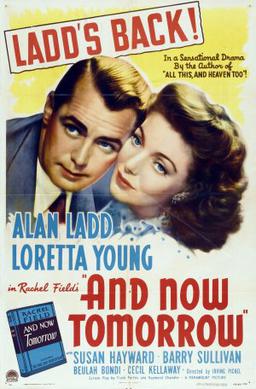
And Now Tomorrow is a 1944 American drama film based on the best-selling novel, published in 1942 by Rachel Field, directed by Irving Pichel and written by Raymond Chandler. Both center around one doctor's attempt for curing deafness. The film stars Alan Ladd, Loretta Young, and Susan Hayward. Its tagline was Who are you that a man can't make love to you?. It is also known as Prisoners of Hope.

Star Spangled Rhythm is a 1942 American all-star cast musical film made by Paramount Pictures during World War II as a morale booster. Many of the Hollywood studios produced such films during the war, generally musicals, frequently with flimsy storylines, and with the specific intent of entertaining the troops overseas and civilians back home and to encourage fundraising – as well as to show the studios' patriotism. This film was also the first released by Paramount to be shown for 8 weeks.
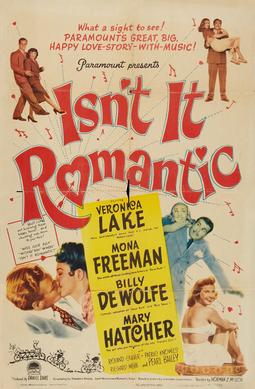
Isn't It Romantic? is a 1948 American comedy musical film from Paramount Pictures, directed by Norman Z. McLeod and starring Veronica Lake and Billy De Wolfe. Supporting actors included Mona Freeman, Richard Webb and Pearl Bailey. Although it takes its title from a 1932 song by Richard Rodgers and Lorenz Hart, it is based on a novel called Gather Ye Rosebuds by Jeannette C. Nolan.

The Glass Key is a 1942 American crime drama based on the 1931 novel of the same name by Dashiell Hammett. The picture was directed by Stuart Heisler starring Brian Donlevy, Veronica Lake and Alan Ladd. A successful earlier film version starring George Raft in Ladd's role had been released in 1935. The 1942 version's supporting cast features William Bendix, Bonita Granville, Richard Denning and Joseph Calleia.

I Wanted Wings is a 1941 American drama film directed by Mitchell Leisen and based on a book by Lieutenant Beirne Lay Jr. The film stars Ray Milland and William Holden. The supporting cast includes Wayne Morris, Brian Donlevy, Constance Moore and Veronica Lake. I Wanted Wings features Lake's first major film role. Her career took off shortly thereafter; the same year, she starred in Sullivan's Travels. Lake would become one of the most popular and successful actresses of the early 1940s.
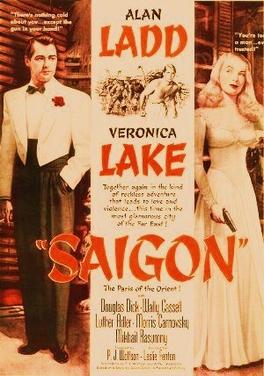
Saigon is a 1948 American crime film directed by Leslie Fenton starring Alan Ladd and Veronica Lake. In their fourth and final film together. It was distributed by Paramount Pictures and was one of the last films Veronica Lake made under her contract with the studio. Ladd and Lake made four films together; This Gun for Hire and The Glass Key, both in 1942, The Blue Dahlia in 1946 and Saigon. While the earlier films all proved to be big box office successes, Saigon did not do as well financially. Ladd continued to remain one of Paramount's top male stars, while Lake's career was in decline. By the end of 1948 her contract with Paramount had expired and the studio chose not to renew it.

Flying Blind is a 1941 American action and comedy film directed by Frank McDonald and distributed by Paramount Pictures. The film was the second movie from Pine-Thomas Productions. That company's first three films formed an unofficial "aviation trilogy"; all starred Richard Arlen.

Miss Susie Slagle's is a 1946 American drama film directed by John Berry. It was based on the popular novel by Augusta Tucker. The film was Berry's directorial debut and first starring role for Joan Caulfield.
Hold That Blonde is a 1945 American comedy film directed by George Marshall. It stars Eddie Bracken and Veronica Lake.
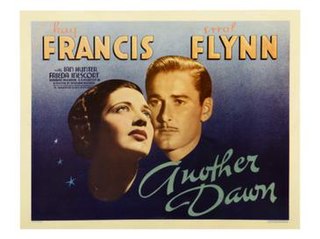
Another Dawn is a 1937 American film melodrama directed by William Dieterle and starring Errol Flynn and Kay Francis. It is based on Somerset Maugham's 1919 play Caesar's Wife. The film received dismissive reviews.
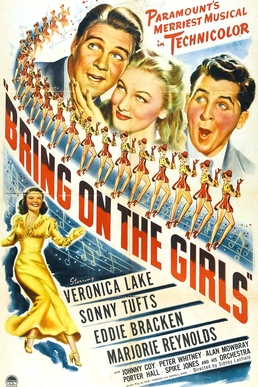
Bring on the Girls is a 1945 American musical comedy film starring Eddie Bracken, Sonny Tufts and Veronica Lake. It is loosely based on the 1940 French comedy The Man Who Seeks the Truth.


















